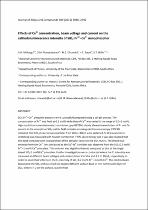 ResearchSpace
ResearchSpace
Effects of Ce3+ concentration, beam voltage and current on the cathodoluminescence intensity of SiO2: Pr3+–Ce3+ nanophosphor
JavaScript is disabled for your browser. Some features of this site may not work without it.
- ResearchSpace
- →
- Research Publications/Outputs
- →
- Journal Articles
- →
- View Item
| dc.contributor.author |
Mhlongo, Gugu H

|
|
| dc.contributor.author |
Ntwaeaborwa, OM

|
|
| dc.contributor.author |
Dhlamini, MS

|
|
| dc.contributor.author |
Swart, HC

|
|
| dc.contributor.author |
Hillie, KT

|
|
| dc.date.accessioned | 2012-03-02T13:08:53Z | |
| dc.date.available | 2012-03-02T13:08:53Z | |
| dc.date.issued | 2011-02 | |
| dc.identifier.citation | Mhlongo, GH, Ntwaeaborwa, OM, Dhlamini, MS, Swart, HC and Hillie, KT. 2011. Effects of Ce3+ concentration, beam voltage and current on the cathodoluminescence intensity of SiO2: Pr3+–Ce3+ nanophosphor. Journal of Alloys and Compounds, vol. 509(6), pp 2986–2992 | en_US |
| dc.identifier.issn | 0925-8388 | |
| dc.identifier.uri | http://www.sciencedirect.com/science/article/pii/S0925838810029427 | |
| dc.identifier.uri | http://hdl.handle.net/10204/5627 | |
| dc.description | Copyright: 2011 Elsevier. This is an ABSTRACT ONLY. | en_US |
| dc.description.abstract | SiO2:Pr3+–Ce3+ phosphor powders were successfully prepared using a sol–gel process. The concentration of Pr3+ was fixed at 0.2 mol% while that of Ce3+ was varied in the range of 0.2–2 mol%. High resolution transmission electron microscopy (HRTEM) clearly showed nanoclusters of Pr and Ce present in the amorphous SiO2 matrix, field emission scanning electron microscopy (FE-SEM) indicated that SiO2 clustered nanoparticles from 20 to 120 nm were obtained. Si–O–Si asymmetric stretching was measured with Fourier transform-IR (FT-IR) spectroscopy and it was also realized that this band increased with incorporation of the activator ions into the SiO2 matrix. The broad blue emission from the Ce3+ ions attributed to the 5d1–4f1 transition was observed from the SiO2:0.2 mol% Pr3+–1 mol% Ce3+ phosphor. This emission was slightly enhanced compared to that of the singly doped SiO2:1 mol%Ce3+ phosphor. Further investigations were conducted where the CL intensity was measured at different beam voltages and currents from 1 to 5 kV and 8.5 to 30 µA, respectively, in order to study their effects on the CL intensity of SiO2:0.2 mol% Pr3+–1 mol% Ce3+. The electron-beam dissociated the SiO2 and as a result an oxygen-deficient surface dead or non-luminescent layer of SiOx, where x < 2 on the surface, was formed. | en_US |
| dc.language.iso | en | en_US |
| dc.publisher | Elsevier | en_US |
| dc.relation.ispartofseries | Workflow;7877 | |
| dc.relation.ispartofseries | Workflow;8120 | |
| dc.subject | Cathodoluminescence | en_US |
| dc.subject | Energy transfer | en_US |
| dc.subject | Degradation | en_US |
| dc.title | Effects of Ce3+ concentration, beam voltage and current on the cathodoluminescence intensity of SiO2: Pr3+–Ce3+ nanophosphor | en_US |
| dc.type | Article | en_US |
| dc.identifier.apacitation | Mhlongo, G. H., Ntwaeaborwa, O., Dhlamini, M., Swart, H., & Hillie, K. (2011). Effects of Ce3+ concentration, beam voltage and current on the cathodoluminescence intensity of SiO2: Pr3+–Ce3+ nanophosphor. http://hdl.handle.net/10204/5627 | en_ZA |
| dc.identifier.chicagocitation | Mhlongo, Gugu H, OM Ntwaeaborwa, MS Dhlamini, HC Swart, and KT Hillie "Effects of Ce3+ concentration, beam voltage and current on the cathodoluminescence intensity of SiO2: Pr3+–Ce3+ nanophosphor." (2011) http://hdl.handle.net/10204/5627 | en_ZA |
| dc.identifier.vancouvercitation | Mhlongo GH, Ntwaeaborwa O, Dhlamini M, Swart H, Hillie K. Effects of Ce3+ concentration, beam voltage and current on the cathodoluminescence intensity of SiO2: Pr3+–Ce3+ nanophosphor. 2011; http://hdl.handle.net/10204/5627. | en_ZA |
| dc.identifier.ris | TY - Article AU - Mhlongo, Gugu H AU - Ntwaeaborwa, OM AU - Dhlamini, MS AU - Swart, HC AU - Hillie, KT AB - SiO2:Pr3+–Ce3+ phosphor powders were successfully prepared using a sol–gel process. The concentration of Pr3+ was fixed at 0.2 mol% while that of Ce3+ was varied in the range of 0.2–2 mol%. High resolution transmission electron microscopy (HRTEM) clearly showed nanoclusters of Pr and Ce present in the amorphous SiO2 matrix, field emission scanning electron microscopy (FE-SEM) indicated that SiO2 clustered nanoparticles from 20 to 120 nm were obtained. Si–O–Si asymmetric stretching was measured with Fourier transform-IR (FT-IR) spectroscopy and it was also realized that this band increased with incorporation of the activator ions into the SiO2 matrix. The broad blue emission from the Ce3+ ions attributed to the 5d1–4f1 transition was observed from the SiO2:0.2 mol% Pr3+–1 mol% Ce3+ phosphor. This emission was slightly enhanced compared to that of the singly doped SiO2:1 mol%Ce3+ phosphor. Further investigations were conducted where the CL intensity was measured at different beam voltages and currents from 1 to 5 kV and 8.5 to 30 µA, respectively, in order to study their effects on the CL intensity of SiO2:0.2 mol% Pr3+–1 mol% Ce3+. The electron-beam dissociated the SiO2 and as a result an oxygen-deficient surface dead or non-luminescent layer of SiOx, where x < 2 on the surface, was formed. DA - 2011-02 DB - ResearchSpace DP - CSIR KW - Cathodoluminescence KW - Energy transfer KW - Degradation LK - https://researchspace.csir.co.za PY - 2011 SM - 0925-8388 T1 - Effects of Ce3+ concentration, beam voltage and current on the cathodoluminescence intensity of SiO2: Pr3+–Ce3+ nanophosphor TI - Effects of Ce3+ concentration, beam voltage and current on the cathodoluminescence intensity of SiO2: Pr3+–Ce3+ nanophosphor UR - http://hdl.handle.net/10204/5627 ER - | en_ZA |





